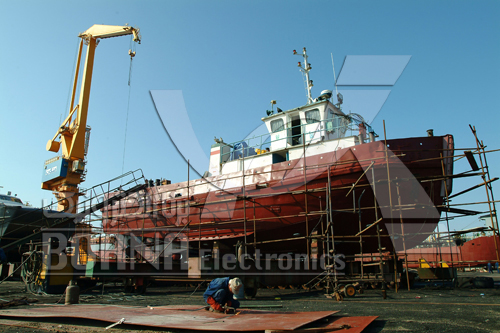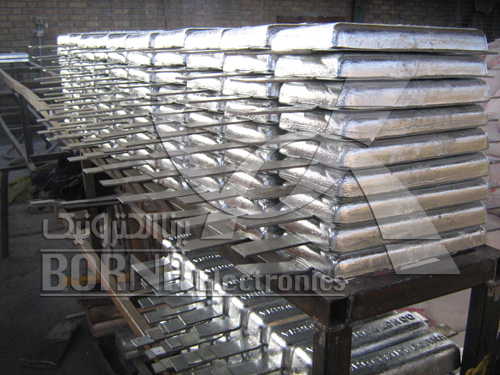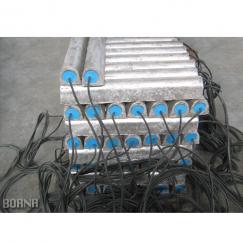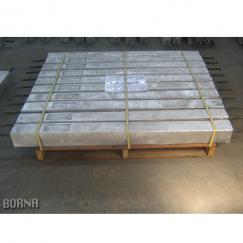Zinc Anodes
Zinc anodes are used to protect structures submerged in fresh or saline water. The main use of these anodes are in cathodic protection of the hull and balance tanks of ships and vessels, internal protection of storage tanks and external protection of submarine pipelines, etc. However, zinc anodes are used to protect buried structures in the soil, such as oil and gas pipelines, the bottom and the external body of storage tanks where soil resistivity is lower and their use is more cost-effective than magnesium anodes.
Zinc anodes are divided into two categories in terms of chemical composition and type of application:
A) Marine zinc alloy (Type I) designed for use in seawater.
B) Standard zinc alloy (Type II) formulated for use in fresh water and soil.
View of a ship being repaired and installed Andes
Zinc anodes manufactured by Borna Electronics Co. for use in the hull of ships
Common standards for zinc anodes include ASTM B418, DIN VG 81257, DNV-RP-B401, IPS-M-TP-750, ISO 15589-2, INSO 12994-2, NACE SP0387, NORSOK M-503 and MIL-A-18001K. According to NACE SP0387 standard, the insert used in zinc anodes shall be of galvanized steel.
Chemical composition of zinc anodes according to ASTM B418 standard
|
Element (Wt%) |
Chemical composition |
|
|
Type I alloy |
Type II alloy |
|
|
Aluminum |
0.1-0.5 |
0.005 Max. |
|
Cadmium |
0.025-0.07 |
0.003 Max. |
|
Iron |
0.005 Max. |
0.0014 Max. |
|
Lead |
0.006 Max. |
0.003 Max. |
|
Copper |
0.005 Max. |
0.002 Max. |
|
Other elements |
0.1 Max. |
– |
|
Zinc |
Reminder |
Reminder |
Electrochemical properties of zinc anodes according to DNV-RP-B401 standard
|
Electrochemical properties |
Type I and II alloys |
|
Electrochemical capacity (A.h/kg) |
780 Min. |
|
Closed circuit potential (V vs Ag/AgCl) |
-1.00 Max. |
|
Efficiency (%) |
95 Min. |
The relative potential between zinc and iron depends on the temperature of the electrolyte. At temperatures above ambient temperature, the potential difference between iron and zinc decreases. In some waters, temperatures above 50 °C change the polarity between iron and zinc. This means that zinc is potentially cathodic than iron and is not only able to protect the iron in a sacrificial manner but also corrodes it faster. Therefore, in electrolytes with operating temperatures above 60 °C shall not be used for iron protection.
Borna Electronics Co. declares its readiness to design and manufacture all types of zinc anodes based on the requests of respected clients or project needs.




